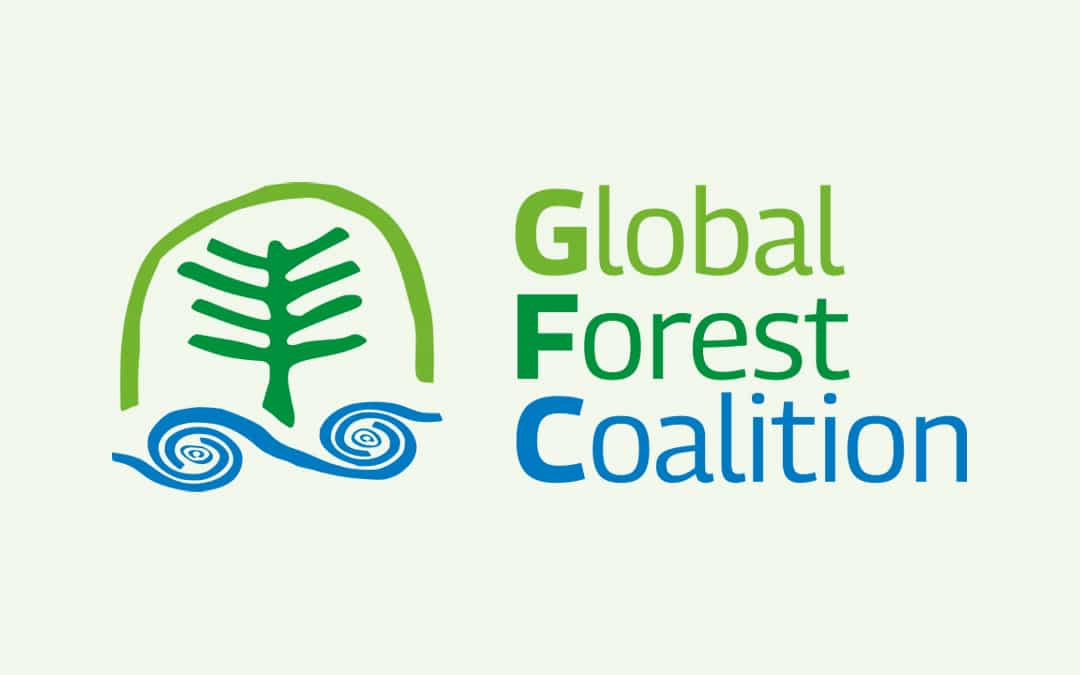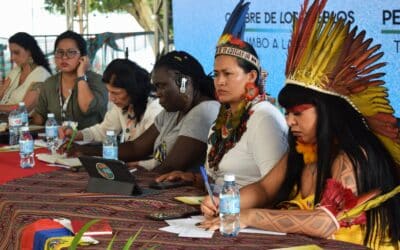Note: The Indigenous Environmental Network’s Clayton Thomas-Muller is quoted in the article. Clayton is on the board of Global Justice Ecology Project (GJEP is the North America Focal Point of the Global Forest Coalition).
–The GJEP Team
—————————————————-
by dawnpaley on 25/02/2011
Source: Briarpatch Magazine latest edition.
March/April 2011.
When representatives from environmental organizations took the stage last May together with logging industry groups to promote what they billed as a new deal to protect Canada’s boreal forest, the announcement came as a surprise to Indigenous peoples across the country. The 72 million hectares encompassed by the deal, known as the Canadian Boreal Forest Agreement (CBFA), is overwhelmingly treaty and traditional First Nations’ territory, yet Indigenous people were left entirely in the dark throughout the negotiation process. According to one Indigenous organizer, his people were “blindsided” by the agreement.
Industry groups, like the Forest Products Association of Canada (FPAC), and environmental non-governmental organizations (ENGOs) touted the Canadian Boreal Forest Agreement as an unprecedented agreement to protect caribou habitat across Canada. Although they were never provided the full text of the agreement in the original press release, the mass media lavished praise on the CBFA, with few exceptions.
At the same time, a copy of the full agreement was leaked to the alternative press, revealing that while the agreement claims to suspend logging in 29 million hectares of woodland caribou habitat, industry planned to log only a very small portion of this total area within the three years covered by the agreement. In exchange for “deferring” logging in a patchwork of forest totalling 72,205 hectares, the CBFA provides a green light for FPAC companies to continue to log 684,461 hectares of boreal forest – roughly nine times what is slated to be protected by the agreement in real terms. It also mandates that the environmental groups who have signed on to the agreement – which include Greenpeace, Forest Ethics, the Canadian Boreal Initiative, Canadian Parks and Wilderness Society, and the David Suzuki Foundation, among others – must drop their campaigns against FPAC members and remove evidence of such campaigns from their websites. If you search the Greenpeace website for archival information on the struggle at Grassy Narrows against clearcut logging on traditional Anishinaabeterritory, for example, you’ll find a pop-up ad blocking the content of the website, indicating that all boycott campaigns directed against FPAC members have been suspended in light of the Boreal Forest Agreement.
The CBFA is a new incarnation of an age-old tradition of environmental and corporate deal-making in which Indigenous peoples are the last to learn of agreements and projects in their own territories.
“I’ve always been concerned about environmental groups,” said Russell Diabo, a Mohawk activist and advocate for Indigenous rights over the past 30 years. “I’ve watched environmental organizations from the animal rights movement, the anti-trapping movement and that, totally ignore Indigenous rights, through to in British Columbia where they have tried to take over [Indigenous] campaigns.”
For Diabo and others, the CBFA is just the latest manifestation of this kind of behaviour.
“It’s showing industry how to make Native people the last to know,” said Mel Bazil of the Wet’suwet’en and Gitxsan nations. “That’s the real issue behind all this for me: make the Native people the last to know and you’ll get what you want eventually.”
Ten months on, backlash against the CBFA has spread across the country. Resistance to the agreement shares a fundamental rejection of backroom decision-making regarding First Nations lands, but varies in character from region to region.
Some groups, including the Indigenous Environmental Network (IEN), condemned the CBFA immediately after the agreement was announced.
“When the CBFA dropped, the IEN came out highly critical of the agreement, and highly critical of the process,” IEN’s Clayton Thomas-Muller told Briarpatch. “We had a lot of criticisms around transparency, around accountability and around the legality of the actual agreement between the forestry sector and ENGOs.”
Others, like Harry St. Denis from the Wolf Lake Algonquin Nation, wrote that the CBFA is “the best recent example of our rights being ignored.” In September, St. Denis successfully moved a motion at the Assembly of First Nations of Quebec and Labrador that, among other things, commits member groups to a technical review of the agreement and prevents member nations from attending any national meetings about the CBFA until their review is complete.
Part of the impetus for St. Denis’ intervention against the CBFA may also have to do with his nation’s access to the emerging carbon market. In July, he proposed a draft resolution to the Assembly of First Nations directing the organization to advocate for a First Nations-specific carbon offset fund to help First Nations capitalize on carbon trading mechanisms, including proposed cap-and-trade legislation.
“I know there’s a big debate about whether carbon trading is a wise thing to do in terms of climate change,” said Diabo. “But the position of the Wolf Lake First Nation, who I work for, is that if there is any benefit, it should accrue to them and not to the logging companies as part of their tenure or to the governments.”
While the CBFA doesn’t deal directly with emissions offsets, critics insist that it sets up a framework that can be used as a guide for an offsetting scheme in the boreal forest.
Fallout in the Forest?
Perhaps the most tangible outcome of the CBFA thus far is the division it has created, not only between ENGOs and Indigenous communities, but also among Indigenous groups and organizations across the country.“I think that, if anything, the CBFA has resulted in an immense fracturing, not only in the ENGO sector, but also among First Nations,” said Thomas-Muller. The attempt by a B.C. tribal council to host a national meeting to discuss how First Nations can benefit from a deal like the CBFA is proof of how this has played out since the agreement was announced.
“We got up and started raising the issue of how these agreements can be valid when no organization knocked on any First Nation’s door,” Carrier Sekani Tribal Council (CSTC) Chief David Luggi told Briarpatch. “As a result, Dr. Suzuki came up here in early July and provided us with a written apology for not including us.”
In October, CSTC called for a national meeting of First Nations in Prince George to discuss the future of the deal. “Some have misconstrued that we are wanting to be party to the existing agreement,” said Luggi. “That is not correct. All we wanted to do is open the door here, see what happens, and see what we can do for our people in terms of protection.”
Luggi admits that the meeting failed to attract First Nations on a national level, and was instead a meeting where “several First Nations” discussed the deal. The meeting in Prince George was boycotted by various nations, especially those from Quebec, but included the participation of advocates of the CBFA, including Larry Innes from the controversial Canadian Boreal Initiative (CBI), which is playing an increasingly important behind-the-scenes role in environmental circles.
The CBI, together with the Pew Environment Group’s International Boreal Conservation Campaign, were major backers of getting the CBFA off the ground. Neither of these groups exist as legal entities in either Canada or the United States, but are instead front groups of a multi-billion dollar charitable foundation – Pew Charitable Trusts – with a long history of establishing ostensibly environmental organizations to pursue its industry-friendly agenda.
Since the CBI does not exist as a legal entity in Canada, it cannot issue cheques or even run a payroll for its employees. Consequently, funds for the meeting in Prince George were funneled to the CSTC through a donation by Ducks Unlimited to the First Nations Energy and Mining Council of British Columbia.
“We’ve done work with the CBI, with Larry Innes, and it’s just a simple meeting that we kinda helped coordinate with Carrier Sekani Tribal Council,” said Joanna Prince, from the First Nations Energy and Mining Council of British Columbia, who co-hosted the October meeting in Prince George. “So we have a working relationship with him, and he just asked if we could help co-ordinate the meeting.”
In following the money, it is crystal clear that it wasn’t the CTSC alone who had an interest in convening an after-the-fact national meeting of First Nations to discuss the CBFA. Instead, it was Innes and other CBFA signatories who facilitated funding the meeting.
“I think that the proponents of this agreement have been working overtime to try and do damage control on some of these very divisive scenarios that are playing out,” said Thomas-Muller. “There are some very real divisions in terms of the legality of this agreement, and questions about whether it violates existing case law precedents in this country around the duty to consult.”
These divisions may be considered a byproduct of an agreement like the CBFA, but they are also a hallmark of mainstream environmentalism in Canada.
“In a lot of ways, I find the environmental groups are using Indigenous peoples,” Diabo told Briarpatch. “They’re saying, ‘oh these people need capacity building, they’re ignorant, they don’t have any understanding of science, that’s why you need to fund us, so that we can train them, work with them.’ They’re using [Indigenous peoples] to get money from foundations and other sources, based on these arguments, which I find very ethnocentric if not racist.”
Since the CBFA was announced in May, the mainstream press has paid little attention to the fallout among Indigenous communities and grassroots environmental activists. The media has, however, picked up on an openness among tar sands operators to negotiate a similar deal for their sector.
An agreement of this nature cannot be ruled out. In an interview with the Vancouver Media Co-op on the day the CBFA was announced, Steve Kallick, who is the boreal conservation campaigner for the Pew Environment Group, said that his organization would be open to looking to other industries for similar agreements. “They’re not within the four corners of this agreement, but we would love to have similar talks with the oil and gas industry and also with the mining industry as well,” said Kallick.
But according to Diabo, questioning the model of foundation-funded environmentalists is just the first step in moving towards an anti-colonial environmentalism.
“I think complaining about it is not enough. I think we have to organize a campaign of Indigenous peoples and go after these foundations and the sources of funding,” said Diabo. “I think we need to challenge these foundations and say, ‘what are you doing? You’re violating international law here.’”




